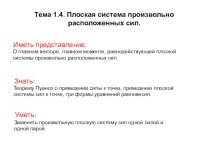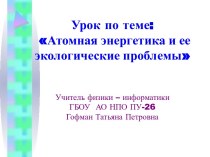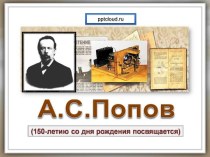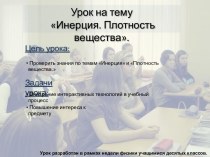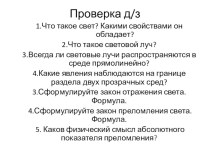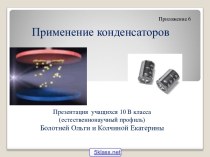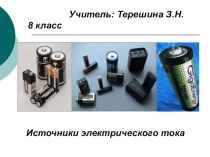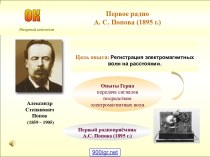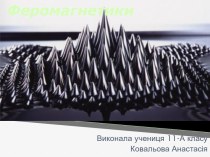- Главная
- Разное
- Бизнес и предпринимательство
- Образование
- Развлечения
- Государство
- Спорт
- Графика
- Культурология
- Еда и кулинария
- Лингвистика
- Религиоведение
- Черчение
- Физкультура
- ИЗО
- Психология
- Социология
- Английский язык
- Астрономия
- Алгебра
- Биология
- География
- Геометрия
- Детские презентации
- Информатика
- История
- Литература
- Маркетинг
- Математика
- Медицина
- Менеджмент
- Музыка
- МХК
- Немецкий язык
- ОБЖ
- Обществознание
- Окружающий мир
- Педагогика
- Русский язык
- Технология
- Физика
- Философия
- Химия
- Шаблоны, картинки для презентаций
- Экология
- Экономика
- Юриспруденция
Что такое findslide.org?
FindSlide.org - это сайт презентаций, докладов, шаблонов в формате PowerPoint.
Обратная связь
Email: Нажмите что бы посмотреть
Презентация на тему Quick Quiz
Содержание
- 2. Course of lectures «Contemporary Physics: Part1»Lecture №4Energy and Energy Transfer.Potential Energy.
- 3. Work Done by a Constant ForceFigure 6.1 An eraser being pushed along a chalkboard tray.
- 4. Figure 6.2 If an object undergoes a
- 5. Figure 6.3 When an object is displaced
- 6. An important consideration for a system approach
- 7. Work Done by a Varying ForceFigure 6.4 The work done by the force
- 8. Figure 6.5 The work done by the
- 9. Work Done by a Spring
- 10. Kinetic Energy and the Work–Kinetic Energy TheoremFigure
- 11. (6.5)where vi is the speed of the
- 12. Kinetic energy is a scalar quantity and
- 13. (a)(b)(c)Figure 6.7 Energy transfer mechanisms. (a) Energy
- 14. Figure 6.7 Energy transfer mechanisms. (d) energy
- 15. One of the central features of the
- 16. PowerThe time rate of energy transfer is
- 17. In a manner similar to the way
- 18. In general, power is defined for any
- 19. Potential Energy of a SystemFigure 6.8 The
- 20. The Isolated System–Conservationof Mechanical EnergyFigure 6.9 The
- 21. Therefore, equating these two expressions for the
- 22. We define the sum of kinetic and
- 23. Equation 6.18 is a statement of conservation
- 24. Conservative and Nonconservative ForcesConservative ForcesNonconservative Forces
- 25. Conservative forces have these two equivalent properties:1.
- 26. Nonconservative ForcesA force is nonconservative if it
- 27. Changes in Mechanical Energyfor Nonconservative Forces(6.19)(6.20)
- 28. Relationship Between Conservative Forcesand Potential Energy(6.21)(6.22)(6.22)
- 29. That is, the x component of a
- 30. Скачать презентацию
- 31. Похожие презентации

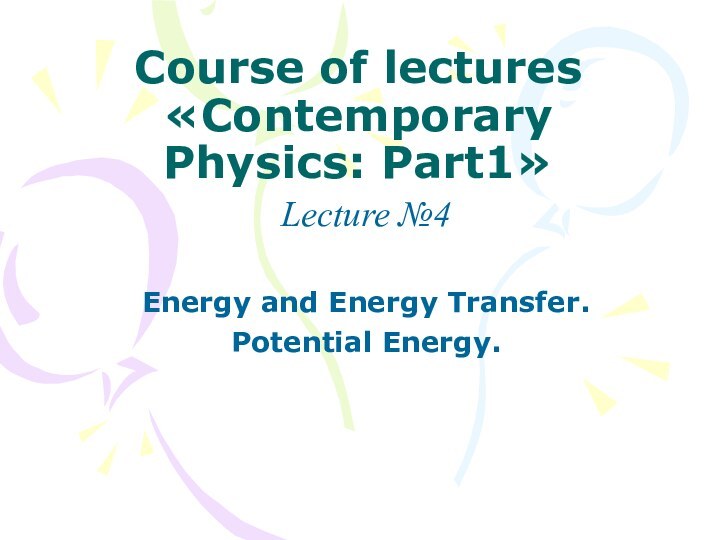
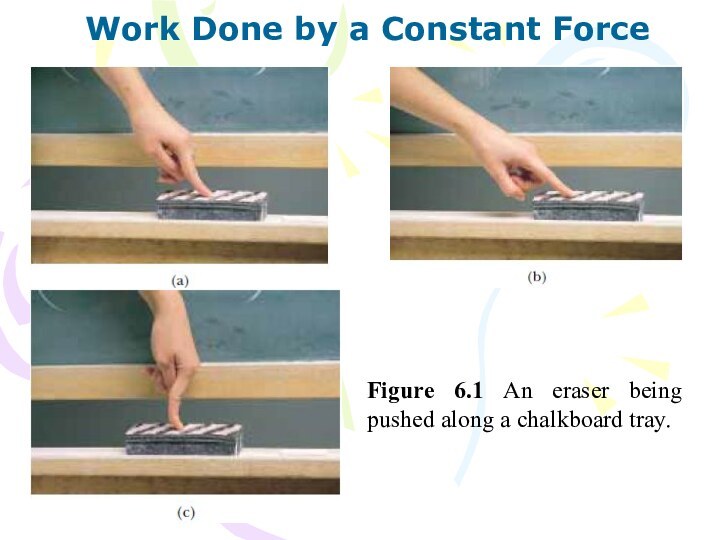
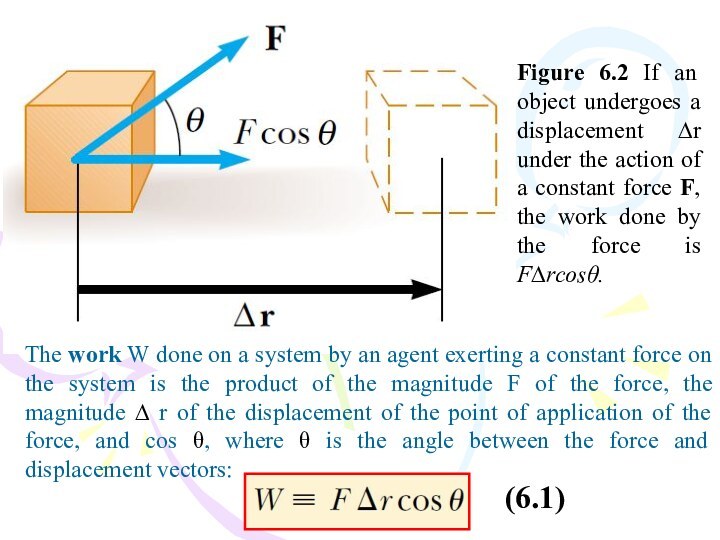
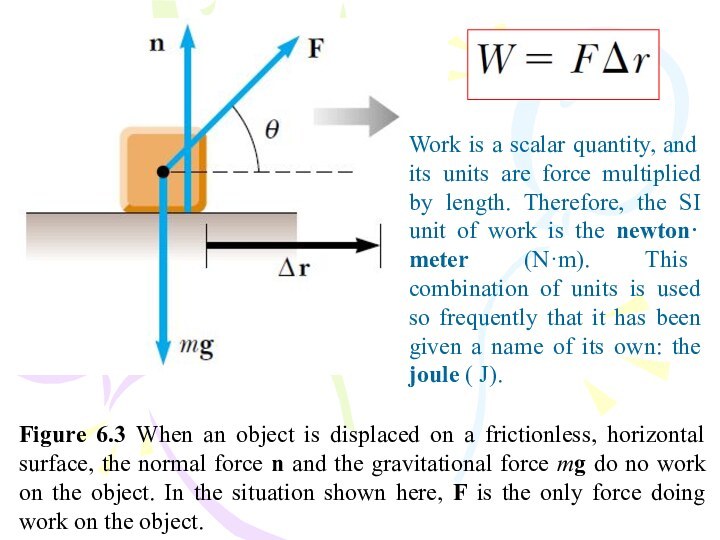

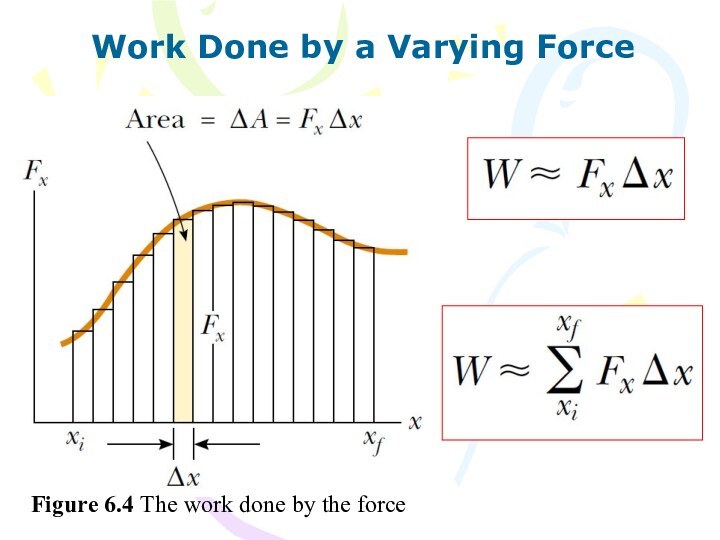
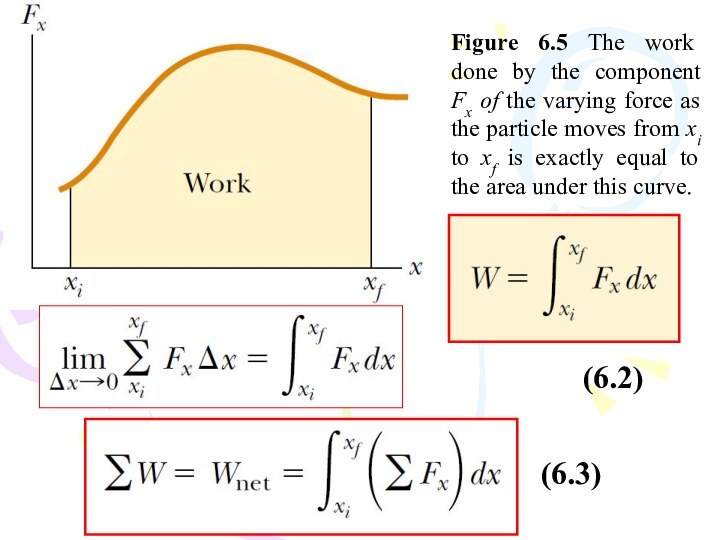

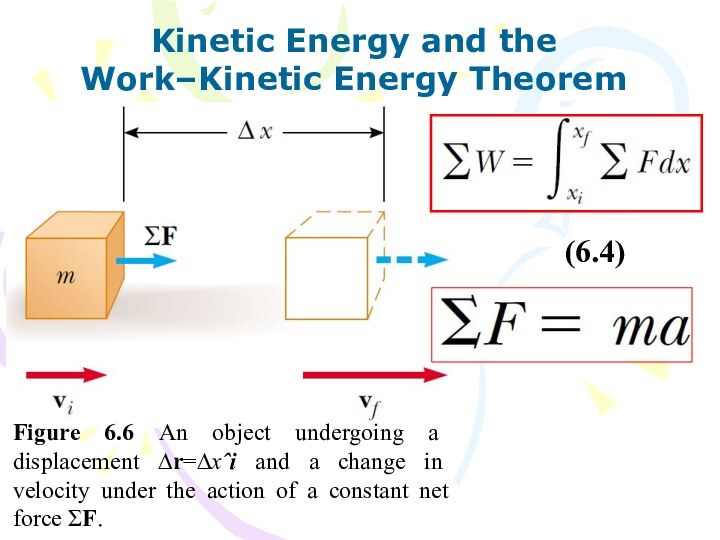
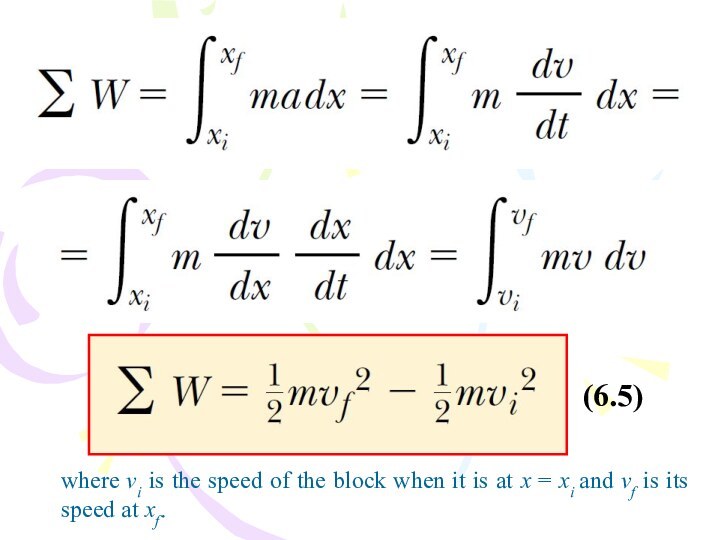


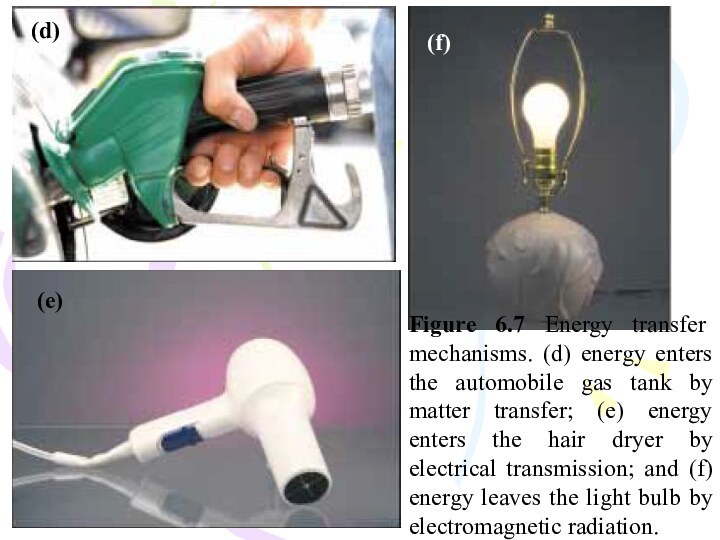
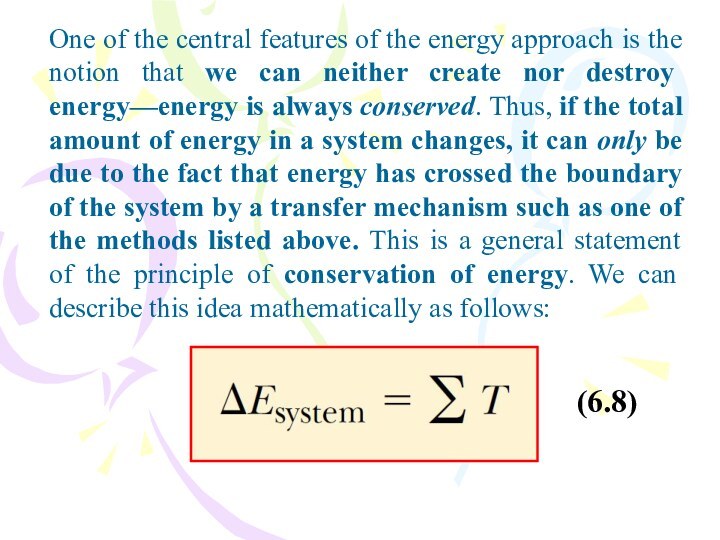

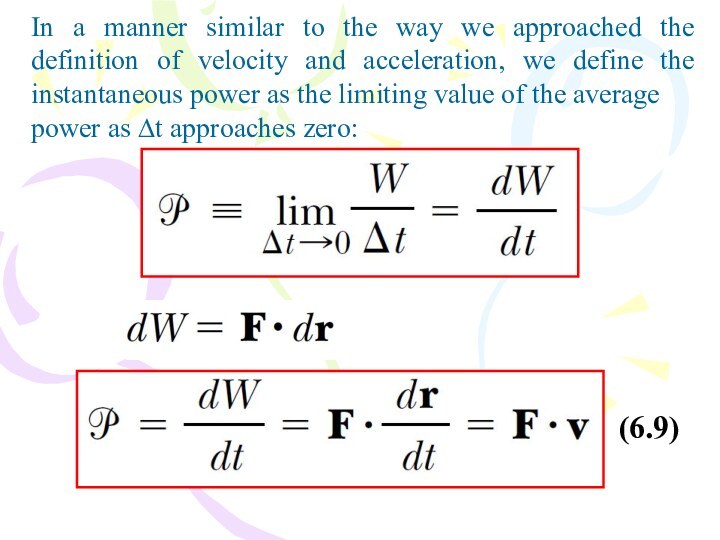

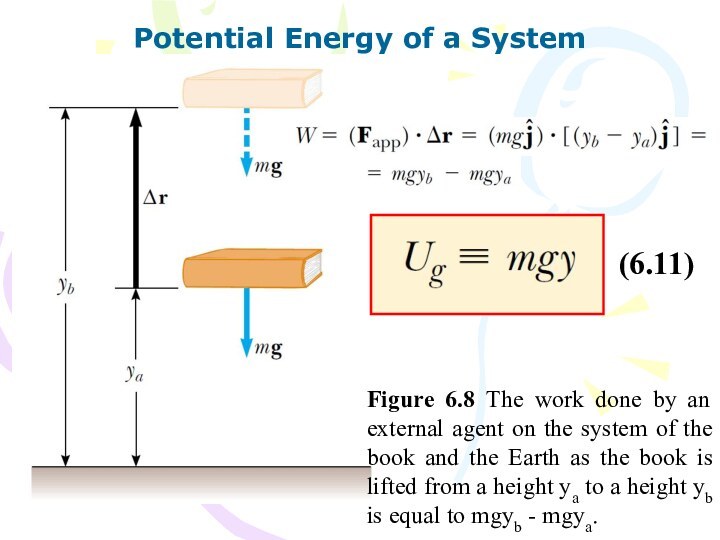

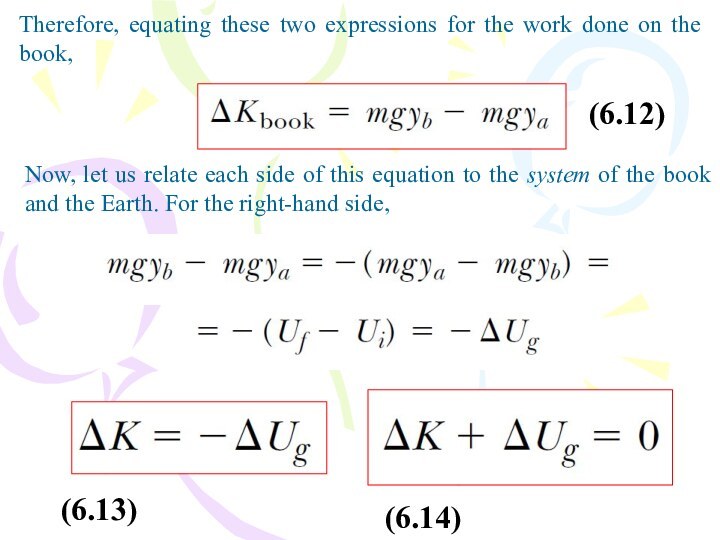




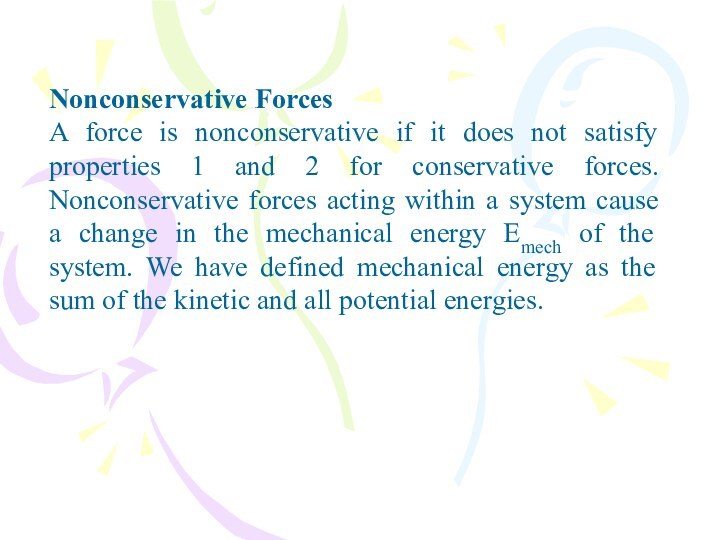




Слайд 4 Figure 6.2 If an object undergoes a displacement
∆r under the action of a constant force F,
the work done by the force is F∆rcosθ.The work W done on a system by an agent exerting a constant force on the system is the product of the magnitude F of the force, the magnitude ∆ r of the displacement of the point of application of the force, and cos θ, where θ is the angle between the force and displacement vectors:
(6.1)
Слайд 5 Figure 6.3 When an object is displaced on
a frictionless, horizontal surface, the normal force n and
the gravitational force mg do no work on the object. In the situation shown here, F is the only force doing work on the object.Work is a scalar quantity, and its units are force multiplied by length. Therefore, the SI unit of work is the newton· meter (N·m). This combination of units is used so frequently that it has been given a name of its own: the joule ( J).
Слайд 6 An important consideration for a system approach to
problems is to note that work is an energy
transfer. If W is the work done on a system and W is positive, energy is transferred to the system; if W is negative, energy is transferred from the system. Thus, if a system interacts with its environment, this interaction can be described as a transfer of energy across the system boundary. This will result in a change in the energy stored in the system.Слайд 8 Figure 6.5 The work done by the component
Fx of the varying force as the particle moves
from xi to xf is exactly equal to the area under this curve.(6.2)
(6.3)
Слайд 10
Kinetic Energy and the Work–Kinetic Energy Theorem
Figure 6.6
An object undergoing a displacement ∆r=∆xˆi and a change
in velocity under the action of a constant net force ƩF.(6.4)
Слайд 12 Kinetic energy is a scalar quantity and has
the same units as work.
(6.6)
(6.7)
Equation 6.7 is an important
result known as the work–kinetic energy theorem:In the case in which work is done on a system and the only change in the system is in its speed, the work done by the net force equals the change in kinetic energy of the system.
Слайд 13
(a)
(b)
(c)
Figure 6.7 Energy transfer mechanisms. (a) Energy is
transferred to the block by work; (b) energy leaves
the radio from the speaker by mechanical waves; (c) energy transfers up the handle of the spoon by heat.Слайд 14 Figure 6.7 Energy transfer mechanisms. (d) energy enters
the automobile gas tank by matter transfer; (e) energy
enters the hair dryer by electrical transmission; and (f) energy leaves the light bulb by electromagnetic radiation.(d)
(e)
(f)
Слайд 15 One of the central features of the energy
approach is the notion that we can neither create
nor destroy energy—energy is always conserved. Thus, if the total amount of energy in a system changes, it can only be due to the fact that energy has crossed the boundary of the system by a transfer mechanism such as one of the methods listed above. This is a general statement of the principle of conservation of energy. We can describe this idea mathematically as follows:(6.8)
Слайд 16
Power
The time rate of energy transfer is called
power. If an external force is applied to an
object (which we assume acts as a particle), and if the work done by this force in the time interval ∆t is W, then the average power during this interval is defined asСлайд 17 In a manner similar to the way we
approached the definition of velocity and acceleration, we define
the instantaneous power as the limiting value of the averagepower as ∆t approaches zero:
(6.9)
Слайд 18 In general, power is defined for any type
of energy transfer. Therefore, the most general expression for
power isThe SI unit of power is joules per second ( J/s), also called the watt (W) (after James Watt):
A unit of power in the U.S. customary system is the horsepower (hp):
(6.10)
Слайд 19
Potential Energy of a System
Figure 6.8 The work
done by an external agent on the system of
the book and the Earth as the book is lifted from a height ya to a height yb is equal to mgyb - mgya.(6.11)
Слайд 20
The Isolated System–Conservation
of Mechanical Energy
Figure 6.9 The work
done by the gravitational force on the book as
the book falls from yb to a height ya is equal to mgyb - mgya.Слайд 21 Therefore, equating these two expressions for the work
done on the book,
Now, let us relate each side
of this equation to the system of the book and the Earth. For the right-hand side,(6.12)
(6.13)
(6.14)
Слайд 22 We define the sum of kinetic and potential
energies as mechanical energy:
We will encounter other types of
potential energy besides gravitational later in the text, so we can write the general form of the definition for mechanical energy without a subscript on U:(6.15)
(6.16)
(6.17)
Слайд 23 Equation 6.18 is a statement of conservation of
mechanical energy for an isolated system. An isolated system
is one for which there are no energy transfers across the boundary. The energy in such a system is conserved—the sum of the kinetic and potential energies remains constant.(6.18)
Слайд 25
Conservative forces have these two equivalent properties:
1. The
work done by a conservative force on a particle
moving between any two points is independent of the path taken by the particle.2. The work done by a conservative force on a particle moving through any closed path is zero. (A closed path is one in which the beginning and end points are identical.)
Слайд 26
Nonconservative Forces
A force is nonconservative if it does
not satisfy properties 1 and 2 for conservative forces.
Nonconservative forces acting within a system cause a change in the mechanical energy Emech of the system. We have defined mechanical energy as the sum of the kinetic and all potential energies.Слайд 29 That is, the x component of a conservative
force acting on an object within a system equals
the negative derivative of the potential energy of the system with respect to x.Relationship Between Conservative Forces
and Potential Energy

